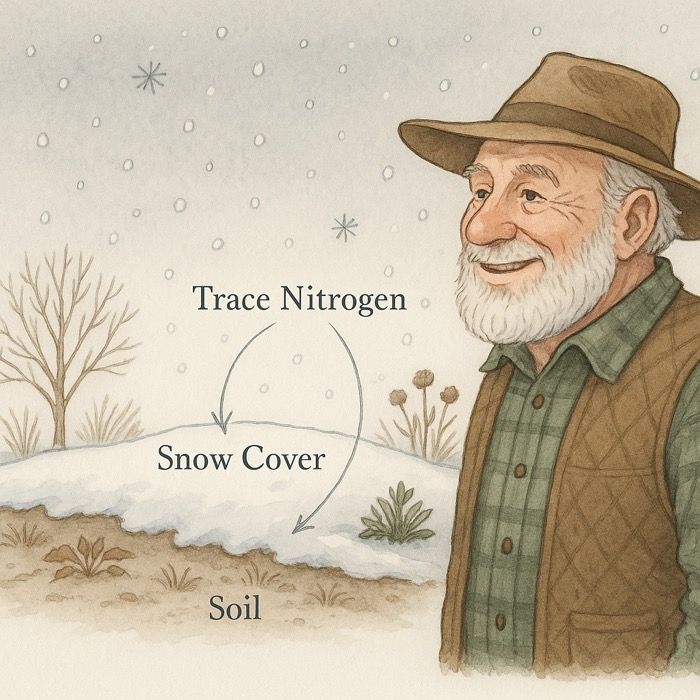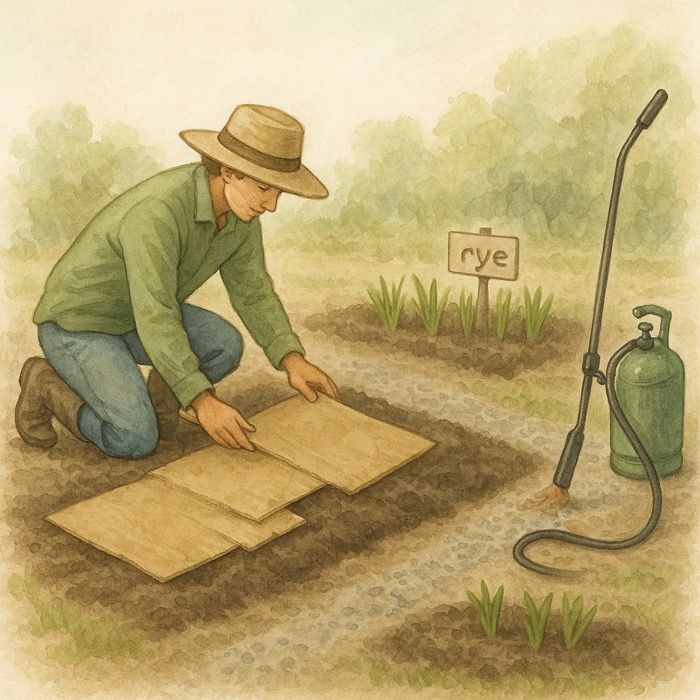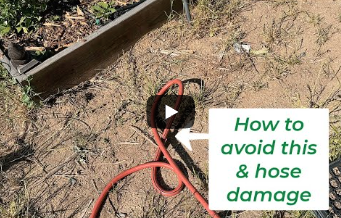Cover Cropping Without Digging – How to Use Cover Crops to Improve Soil Fertility and Structure
Cover Cropping Without Digging is a sustainable and effective method used to enhance soil fertility and improve soil structure without disturbing the soil ecosystem through tilling or digging. This approach aligns with no-till gardening principles, which emphasize soil health and long-term soil productivity. Here’s a deeper look at how cover cropping can transform your garden.
What is Cover Cropping Without Digging?
Cover cropping involves planting specific crops, known as cover crops or green manures, that are not harvested for food but grown to improve soil quality. When using the no-dig method, these cover crops are planted, grown to maturity, and then terminated without turning or tilling the soil. Instead, they are left on the soil surface to decompose naturally, creating a protective mulch layer.
The Science of Cover Cropping
The effectiveness of cover cropping is rooted in soil biology and ecology. When cover crops grow, their root systems interact with soil microbes, forming a complex web of life that supports nutrient cycling and soil structure. Legumes, for example, form a symbiotic relationship with rhizobia bacteria, which convert atmospheric nitrogen into a usable form for plants. Additionally, the organic matter produced by decomposing cover crops fuels soil microbial communities, enhancing soil fertility and stability. Deep-rooted cover crops also help break up compacted soil layers, creating channels for water and air, which further promotes a healthy and balanced soil ecosystem. This science-based approach leverages natural processes to maintain soil health and productivity over the long term.
How Cover Crops Improve Soil Fertility and Structure
- Nutrient Enrichment –
- Nitrogen Fixation – Leguminous cover crops like clover, vetch, and peas form symbiotic relationships with nitrogen-fixing bacteria. These bacteria capture atmospheric nitrogen and convert it into a form that plants can use. When the cover crops decompose, they release this nitrogen into the soil, enriching it for the next planting cycle.
- Nutrient Cycling – Deep-rooted cover crops, such as daikon radish, pull up nutrients from deeper soil layers and bring them closer to the surface. When these crops break down, they make these nutrients accessible to shallow-rooted plants.
- Organic Matter and Soil Structure –
- Increased Organic Matter – As cover crops decompose on the soil surface, they add significant amounts of organic matter to the soil. This organic matter feeds soil organisms like earthworms and microbes, which, in turn, help to build a healthy soil structure.
- Soil Aggregation – The roots of cover crops help bind soil particles together, forming aggregates. These aggregates create a crumbly soil texture that is ideal for plant root growth and improves water infiltration and retention.
- Erosion Prevention and Moisture Retention –
- Erosion Control – Cover crops provide a protective ground cover that shields the soil from wind and water erosion. Their dense root systems hold the soil in place, preventing it from being washed or blown away.
- Water Management – The mulch created by terminated cover crops helps retain soil moisture by reducing evaporation. This is particularly beneficial in dry climates or during periods of drought.
- Weed Suppression –
- Smothering Weeds – Fast-growing cover crops like buckwheat and rye quickly outcompete weeds for light, nutrients, and space. Once terminated, the mulch layer acts as a barrier that prevents weed seeds from germinating.
- Allelopathic Effects – Some cover crops, such as rye, release natural chemicals that inhibit weed seed germination. This adds an extra layer of weed control to your no-dig gardening system.
- Soil Aeration and Compaction Reduction –
- Deep-Rooted Crops – Cover crops like daikon radish or alfalfa have long taproots that penetrate compacted soil layers, creating channels for air and water to move through. This natural aeration improves soil porosity without the need for mechanical tilling.
- Reduced Compaction – By breaking up compacted soil layers, cover crops help maintain a loose and friable soil structure, making it easier for the roots of future crops to grow and access nutrients.
Steps to Implement Cover Cropping Without Digging
- Select the Right Cover Crop –
- Choose cover crops based on your goals. For nitrogen fixation, opt for legumes like clover or vetch. For soil compaction, select crops with deep taproots, like daikon radish.
- Consider a mix of cover crops to achieve multiple benefits, such as a combination of rye and vetch for both biomass and nitrogen.
- Plant at the Appropriate Time –
- Fall Cover Crops – Plant in late summer or early fall to protect the soil over winter and improve fertility in the spring.
- Spring or Summer Cover Crops – Use fast-growing options like buckwheat to cover bare soil during the growing season.
- Grow and Manage
- Let the cover crops grow to their full potential to maximize biomass and nutrient capture. Avoid cutting them too early, as this reduces their effectiveness.
- Monitor the growth to ensure that the cover crops do not go to seed and become a weed problem.
- Terminate Without Digging
- Use methods like crimping, mowing, or cutting to flatten the cover crops. These methods kill the cover crops while leaving their roots intact, preserving soil structure.
- Leave the residue on the soil surface as a mulch layer. Over time, this layer will decompose, adding organic matter and nutrients to the soil.
- Plant Directly into the Mulch
- When it’s time to plant your main crops, create small openings in the mulch layer and plant directly into the soil. The decomposing cover crop residue will continue to feed your plants throughout the growing season.
Best Cover Crops for No-Dig Systems
- Legumes (e.g., Crimson Clover, Hairy Vetch, Field Peas) –
- Ideal for nitrogen fixation and adding organic matter.
- Plant in the fall for spring nitrogen release.
- Grasses (e.g., Winter Rye, Oats, Annual Ryegrass) –
- Great for weed suppression, erosion control, and adding biomass.
- Plant in the fall and terminate in the spring.
- Deep-Rooted Crops (e.g., Daikon Radish, Alfalfa) –
- Excellent for breaking up compacted soil and improving drainage.
- Plant in late summer for soil conditioning.
- Fast-Growing Crops (e.g., Buckwheat, Phacelia) –
- Quick to establish and effective at smothering weeds.
- Ideal for short fallow periods between main crops.
Tips for Success
- Keep the Soil Covered – Always aim to keep the soil covered with either living cover crops or mulch to protect it from the elements.
- Use Diverse Mixes – Planting a variety of cover crops can provide multiple soil benefits and create a more resilient soil ecosystem.
- Patience Pays Off – While cover cropping may not give immediate results, the long-term benefits to soil health and productivity are well worth the effort.
By incorporating cover cropping into your no-dig gardening practices, you can build healthier, more fertile soil that supports robust plant growth and reduces the need for synthetic fertilizers and soil amendments. It’s a natural and effective way to work with the soil, rather than against it, for a thriving, sustainable garden.
More From Our Master Gardener
Recent Posts

❄️ Snow as Fertilizer – The Truth About “Poor Man’s Nitrogen”

5 Unexpected Winter Weed Control Strategies (That Don’t Involve Mulch)

Harnessing Winter Sun – Passive Solar Tricks for Your Garden

How to Grow Spinach – The Ultimate Beginner’s Guide for Tender, Nutritious Leaves

How to Grow Peas: The Ultimate Beginner’s Guide for Sweet, Crisp Harvests














